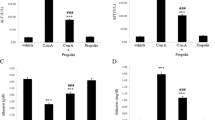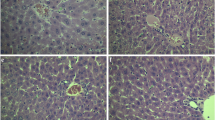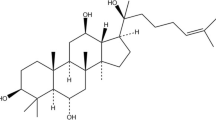Abstract
Objective and design
In this study, the possible protective effect of glycyrrhizin (GL), an active compound derived from licorice root, was examined on T cell-mediated liver injury in mice.
Materials and methods
Mice were subjected to liver injury by intravenous injection of concanavalin A (Con A). They had been treated with GL (i.p.) 30 min before the injection. Liver injury was estimated by measuring serum levels of alanine aminotransaminase (ALT) and aspartate aminotransaminase (AST), and by examining liver sections with hematoxylin–eosin staining. Expression of inducible nitric oxide synthase (iNOS) mRNA and protein in the liver was determined by reverse transcription polymerase chain reaction (RT-PCR) and Western blotting.
Results
Serum transaminases and hepatic iNOS levels increased with time after Con A treatment. Expression of iNOS mRNA in the liver was elevated for up to 8 h, and at 8 h, GL (ED50: 10.5 mg/kg) suppressed the increases in AST and ALT in response to Con A. An increase in iNOS mRNA expression and protein was inhibited by treatment with GL. Furthermore, GL inhibited cell infiltration and the degeneration of hepatocytes in the liver of Con A-treated mice.
Conclusion
The present study suggests that the prevention by GL of Con A-induced hepatitis is due partly to the modulation of hepatic iNOS induction and of degeneration of hepatocytes.




Similar content being viewed by others
References
Yoshikawa M, Matsui Y, Kawamoto H, Umemoto N, Oku K, Koizumi M, et al. Effects of glycyrrhizin on immune-mediated cytotoxicity. J Gastroenterol Hepatol. 1997;12:243–8.
Okamoto T, Kanda T. Glycyrrhizin protects mice from concanavalin A-induced hepatitis without affecting cytokine expression. Int J Mol Med. 1999;4:149–52.
Okamoto T. The protective effect of glycyrrhizin on anti-Fas antibody-induced hepatitis in mice. Eur J Pharmacol. 2000;387:229–32.
Kimura M, Inoue H, Hirabayashi K, Natsume H, Ogihara M. Glycyrrhizin and some analogues induce growth of primary cultured adult rat hepatocytes via epidermal growth factor receptors. Eur J Pharmacol. 2001;431:151–61.
Kimura M, Moro T, Motegi H, Maruyama H, Sekine M, Okamoto H, et al. In vivo glycyrrhizin accelerates liver regeneration and rapidly lowers serum transaminase activities in 70% partially hepatectomized rats. Eur J Pharmacol. 2008;579:357–64.
Yin J, Li D, Hu W, Meng Q. Effects of glycyrrhizic acid on cocklebur-induced hepatotoxicity in rat and human hepatocytes. Phytother Res. 2008;22:395–400.
Tang B, Qiao H, Meng F, Sun X. Glycyrrhizin attenuates endotoxin-induced acute liver injury after partial hepatectomy in rats. Braz J Med Biol Res. 2007;40:1637–46.
Yoshida T, Abe K, Ikeda T, Matsushita T, Wake K, Sato T, et al. Inhibitory effect of glycyrrhizin on lipopolysaccharide and d-galactosamine-induced mouse liver injury. Eur J Pharmacol. 2007;576:136–42.
Abe K, Ikeda T, Wake K, Sato T, Sato T, Inoue H. Glycyrrhizin privents of lipopolysaccharide/d-galactosamine-induced liver injury through down-regulation of matrix metalloproteinase-9 in mice. J Pharm Pharmacol. 2008;60:91–7.
Iino S, Tango T, Matsushima T, Toda G, Miyake K, Hino K, et al. Therapeutic effects of stronger neo-minophagen C at different doses on chronic hepatitis and liver cirrhosis. Hepatol Res. 2001;19:31–40.
Arase Y, Ikeda K, Murashima N, Chayama K, Tsubota A, Koida I, et al. The long term efficacy of glycyrrhizin in chronic hepatitis C patients. Cancer. 1997;79:1494–500.
Ikeda M, Fujiyama S, Tanaka M, Sata M, Ide T, Yatsuhashi H, et al. Clinical features of hepatocellular carcinoma that occur after sustained virological response to interferon for chronic hepatitis C. J Gastroenterol Hepatol. 2006;21:122–8.
Hidaka I, Hino K, Korenaga M, Gondo T, Nishina S, Ando M, et al. Stronger Neo-Minophagen C, a glycyrrhizin-containing preparation, protects liver against carbon tetrachloride-induced oxidative stress in transgenic mice expressing the hepatitis C virus polyprotein. Liver Int. 2007;27:845–53.
van Rossum TG, Vulto AG, Hop WC, Schalm SW. Pharmacokinetics of intravenous glycyrrhizin after single and multiple doses in patients with chronic hepatitis C infection. Clin Ther. 1999;21:2080–90.
van Rossum TG, Vulto AG, Hop WC, Schalm SW. Glycyrrhizin-induced reduction of ALT in European patients with chronic hepatitis C. Am J Gastroenterol. 2001;96:2432–7.
Tiegs G, Hentschel J, Wendel A. A T cell-dependent experimental liver injury in mice inducible by concanavalin A. J Clin Invest. 1992;90:196–203.
Sass G, Heinlein S, Agli A, Bang R, Schümann J, Tiegs G. Cytokine expression in three mouse models of experimental hepatitis. Cytokine. 2002;19:115–20.
Jaruga B, Hong F, Kim WH, Gao B. IFN-gamma/STAT1 acts as a proinflammatory signal in T cell-mediated hepatitis via induction of multiple chemokines and adhesion molecules: a critical role of IRF-1. Am J Physiol Gastrointest Liver Physiol. 2004;287:G1044–52.
Fujikura S, Mizuhara H, Miyazawa Y, Fujiwara H, Kaneda K. Kinetics and localization of lymphoblasts that proliferate in the mutine liver after Concanavalin A administration. Biomed Res. 1996;17:129–39.
Beckman JS, Koppenol WH. Nitric oxide, superoxide, and peroxynitrite: the good, the bad, and ugly. Am J Physiol. 1996;271:C1424–37.
Halliwell B. What nitrates tyrosine? Is nitrotyrosine specific as a biomarker of peroxynitrite formation in vivo? FEBS Lett. 1997;411:157–60.
Christopherson KS, Bredt DS. Nitric oxide in excitable tissues: physiological roles and diseases. J Clin Invest. 1997;100:2424–9.
Harrison DG. Cellular and molecular mechanisms of endothelial cell dysfunction. J Clin Invest. 1997;100:2153–7.
Sass G, Koerber K, Bang R, Guehring H, Tiegs G. Inducible nitric oxide synthase is critical for immune-mediated liver injury in mice. J Clin Invest. 2001;107:439–47.
Ito Y, Abril Edward R, Bethea Nancy W, McCuskey Robert S. Role of nitric oxide in hepatic microvascular injury elicited by acetaminophen in mice. Am J Physiol Gastrointest Liver Physiol. 2004;286:G60–7.
Ma XL, Li YH, Gao JX, Li J, Guo L, Wu CZ. Expression of inducible nitric oxide synthase in the liver is under the control of nuclear factor kappa B in concanavalin A-induced hepatitis. J Gastroenterol Hepatol. 2008;23:e231–5.
Ohuchi K, Kamada Y, Levine L, Tsurufuji S. Glycyrrhizin inhibits prostaglandin E2 production by activated peritoneal macrophages from rats. Prostaglandins Med. 1981;7:457–63.
Okimasu E, Moromizato Y, Watanabe S, Sasaki J, Shiraishi N, Morimoto YM, et al. Inhibition of phospholipase A2 and platelet aggregation by glycyrrhizin, an antiinflammation drug. Acta Med Okayama. 1983;37:385–91.
Feng C, Wang H, Yao C, Zhang J, Tian Z. Diammonium glycyrrhizinate, a component of traditional Chinese medicine Gan-Cao, prevents murine T-cell-mediated fulminant hepatitis in IL-10- and IL-6-dependent manners. Int Immunopharmacol. 2007;7:1292–8.
Abe M, Akbar F, Hasebe A, Horiike N, Onji M. Glycyrrhizin enhances interleukin-10 production by liver dendritic cells in mice with hepatitis. J Gastroenterol. 2003;38:962–7.
Lee CH, Park SW, Kim YS, Kang SS, Kim JA, Lee SH, et al. Protective mechanism of glycyrrhizin on acute liver injury induced by carbon tetrachloride in mice. Biol Pharm Bull. 2007;30:1898–904.
Wang JY, Guo JS, Li H, Liu SL, Zern MA. Inhibitory effect of glycyrrhizin on NF-kappaB binding activity in CCl4- plus ethanol-induced liver cirrhosis in rats. Liver. 1998;18:180–5.
Acknowledgments
The authors acknowledge Dr. A.F. Walls, Southampton General Hospital, UK, for reading the manuscript in preparation. We thank Prof. T. Sato, Department of Anatomy (Division 2), School of Dental Medicine Tsurumi University, Japan, for support in the pathological estimation of this study, and we are also grateful to Mr. C. W. P. Reynolds for his careful linguistic revision of this manuscript.
Author information
Authors and Affiliations
Corresponding author
Additional information
Responsible Editor: M. Katori.
Rights and permissions
About this article
Cite this article
Tsuruoka, N., Abe, K., Wake, K. et al. Hepatic protection by glycyrrhizin and inhibition of iNOS expression in concanavalin A-induced liver injury in mice. Inflamm. Res. 58, 593–599 (2009). https://doi.org/10.1007/s00011-009-0024-8
Received:
Revised:
Accepted:
Published:
Issue Date:
DOI: https://doi.org/10.1007/s00011-009-0024-8




